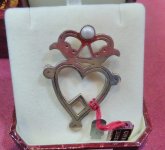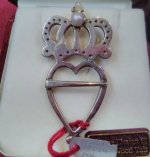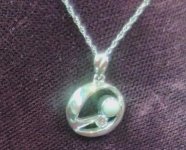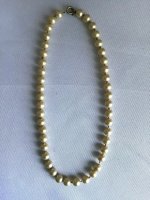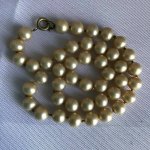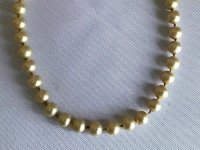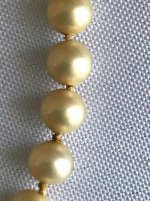loopysheep
New Member
- Joined
- Sep 30, 2019
- Messages
- 14
These are the real deal. I purchased these from Alistair Tait in Edinburgh. They are licensed by Scottish Natural Heritage (SNH) to create new jewellery from Scottish river pearls collected before 27 March 1991. Every time he creates a piece, he says that his collection of pearls diminishes, and when they're gone, that's it. SNH have no plans anytime soon to allow anyone to resume collecting river pearls. The species is currently decimated by illegal poaching and other reasons. The show Outlander has caused a fever for them, and beds have been greatly disturbed in recent years - with no pearls found. It is incredibly harmful to our environment here, and SNH has had to work hard with local communities and the police to try to crack down on the poachers. The freshwater pearl mussel (Margaritifera margaritifera) is endangered.
SNH's report (2015) states (where 'recruitment' means the species is showing signs of growing or increasing):
- Of 125 watercourses for which post-1998 pearl mussel data are available, 71 showed signs of recent successful recruitment and 43 were not successfully recruiting. Since the first national survey, freshwater pearl mussels have apparently become extinct in 11 watercourses.
- All of the extinctions occurred in watercourses where the mussel populations had previously been assessed as “functionally extinct” i.e. without evidence of recruitment. Extinctions occurred in all hydrological regions for which the total sample size exceeded one watercourse.
-All of the extinctions occurred in watercourses where the mussel populations had previously been assessed as “functionally extinct” i.e. without evidence of recruitment. Extinctions occurred in all hydrological regions for which the total sample size exceeded one watercourse.
-Of the 105 watercourses for which both baseline and current data were available, the pearl mussel population status remained unchanged in 79. Evidence of substantial decline (either extinction or failure of recruitment) was evident in 20 watercourses. No strong regional variation in decline was identified.
-Apparent improvements occurred in only six watercourses. The improved classifications of three rivers resulted from finding single juvenile mussels and may be considered tenuous. Evidence of more regular and recent recruitment was identified in one particular watercourse.
-An analysis of threats was carried out based on survey findings, surveyors’ wider knowledge of the rivers, published data and records of pearl fishing incidents.
-Pearl fishing was identified as having occurred since the first national survey (and subsequent ban) on a minimum of 35.2% of rivers. This included a high proportion of designated sites (SACs and/or Sites of Special Scientific Interest).
-Water quality (incl. pollution) and hydrological alterations (inc. river engineering, and abstractions) were identified as threats on 25.4% and 18.0% of watercourses respectively. These figures may be conservative.
-Declines or low numbers of host fish were apparent in 27.0% of watercourses. There was a strong regional trend, with lack of host fish identified as a threat on 43.1% of west Highland watercourses. The figure may be conservative.
-Climate change and associated habitat instability was identified as a direct concern in 21.3% of watercourses. In most regions the figure was close to 25%, but only 15.4% of West Highland rivers were identified as threatened. This may be a substantial underestimate as the natural instability of spate rivers makes change difficult to identify unless it is clear that loss of previously recorded habitat has occurred.
Overall, the data suggest a pattern of continuing decline of M. margaritifera in Scotland. Among the most pressing needs is a better understanding of the factors underlying recruitment failure.
Now that the scientific evidence is complete, I hope it is clear just how rare and precious these oval drops are. Alistair Tait has only been able to create one other pair of earrings like this, and they were created for his son. I am a regular customer at his shop.
I am not going to state how much I paid. Please don't ask. I bought these because I believe in preserving heritage. These pieces will never be treated with anything other than the respect they deserve. I will wear them and cherish them all the days of my life. I hope one day to give them to my descendants.
I bought these because I believe in preserving heritage. These pieces will never be treated with anything other than the respect they deserve. I will wear them and cherish them all the days of my life. I hope one day to give them to my descendants.
They are handcrafted on 18ct gold. The posts contain a number of tiny hallmarks that cannot be captured except on very good macro lenses, which I do not have. Sorry! I can fit them into my knitting needle gauge, to give you an idea of size. If you knit, that will give you an idea of the difference of sizes between them.
If you knit, that will give you an idea of the difference of sizes between them.
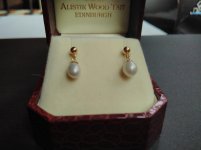
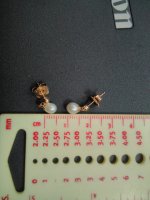
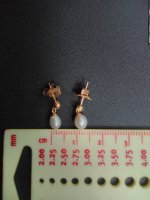
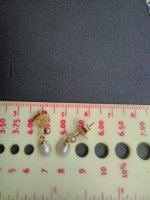
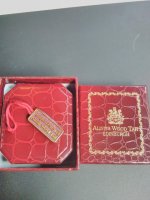
These two images are from postcards that Alistair Tait kindly provided for me. They give a good selection of images of what Scottish pearls in his collection have looked like over the years. The earrings have been sold.
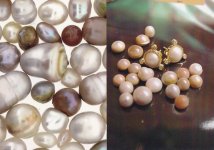
SNH's report (2015) states (where 'recruitment' means the species is showing signs of growing or increasing):
- Of 125 watercourses for which post-1998 pearl mussel data are available, 71 showed signs of recent successful recruitment and 43 were not successfully recruiting. Since the first national survey, freshwater pearl mussels have apparently become extinct in 11 watercourses.
- All of the extinctions occurred in watercourses where the mussel populations had previously been assessed as “functionally extinct” i.e. without evidence of recruitment. Extinctions occurred in all hydrological regions for which the total sample size exceeded one watercourse.
-All of the extinctions occurred in watercourses where the mussel populations had previously been assessed as “functionally extinct” i.e. without evidence of recruitment. Extinctions occurred in all hydrological regions for which the total sample size exceeded one watercourse.
-Of the 105 watercourses for which both baseline and current data were available, the pearl mussel population status remained unchanged in 79. Evidence of substantial decline (either extinction or failure of recruitment) was evident in 20 watercourses. No strong regional variation in decline was identified.
-Apparent improvements occurred in only six watercourses. The improved classifications of three rivers resulted from finding single juvenile mussels and may be considered tenuous. Evidence of more regular and recent recruitment was identified in one particular watercourse.
-An analysis of threats was carried out based on survey findings, surveyors’ wider knowledge of the rivers, published data and records of pearl fishing incidents.
-Pearl fishing was identified as having occurred since the first national survey (and subsequent ban) on a minimum of 35.2% of rivers. This included a high proportion of designated sites (SACs and/or Sites of Special Scientific Interest).
-Water quality (incl. pollution) and hydrological alterations (inc. river engineering, and abstractions) were identified as threats on 25.4% and 18.0% of watercourses respectively. These figures may be conservative.
-Declines or low numbers of host fish were apparent in 27.0% of watercourses. There was a strong regional trend, with lack of host fish identified as a threat on 43.1% of west Highland watercourses. The figure may be conservative.
-Climate change and associated habitat instability was identified as a direct concern in 21.3% of watercourses. In most regions the figure was close to 25%, but only 15.4% of West Highland rivers were identified as threatened. This may be a substantial underestimate as the natural instability of spate rivers makes change difficult to identify unless it is clear that loss of previously recorded habitat has occurred.
Overall, the data suggest a pattern of continuing decline of M. margaritifera in Scotland. Among the most pressing needs is a better understanding of the factors underlying recruitment failure.
Now that the scientific evidence is complete, I hope it is clear just how rare and precious these oval drops are. Alistair Tait has only been able to create one other pair of earrings like this, and they were created for his son. I am a regular customer at his shop.
I am not going to state how much I paid. Please don't ask.
They are handcrafted on 18ct gold. The posts contain a number of tiny hallmarks that cannot be captured except on very good macro lenses, which I do not have. Sorry! I can fit them into my knitting needle gauge, to give you an idea of size.





These two images are from postcards that Alistair Tait kindly provided for me. They give a good selection of images of what Scottish pearls in his collection have looked like over the years. The earrings have been sold.


